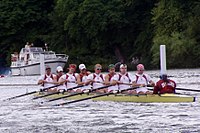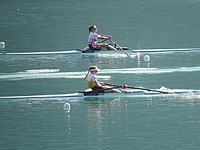
Back Roei Afrikaans تجديف (رياضة) Arabic تجديف ARZ Akademik avarçəkmə Azerbaijani آوارچکمه AZB Академик ишеү Bashkir Акадэмічнае веславанне Byelorussian Акадэмічнае веславаньне BE-X-OLD Академично гребане Bulgarian Roeñverezh Breton
An eight (top) and single sculls (bottom) | |
| Highest governing body | World Rowing Federation |
|---|---|
| First modern-day competition | 1715 [a] |
| Characteristics | |
| Contact | No |
| Team members | 1, 2, 3, 4, 5 or 9 (depending on boat class and whether there is a coxswain) |
| Mixed-sex | Separate competitions |
| Type | Water sport, outdoor |
| Equipment | Racing shell, oars |
| Venue | River, artificial lake, canal, ocean |
| Glossary | Glossary of rowing terms |
| Presence | |
| Olympic | since 1900 (men only); since 1976 (both men and women) |
| Paralympic | since 2008 |
| World Games | Indoor: 2017 |
Rowing, often called crew in the United States, is the sport of racing boats using oars. It differs from paddling sports in that rowing oars are attached to the boat using rowlocks, while paddles are not connected to the boat. Rowing is divided into two disciplines: sculling and sweep rowing. In sculling, each rower holds two oars, one in each hand, while in sweep rowing each rower holds one oar with both hands. There are several boat classes in which athletes may compete, ranging from single sculls, occupied by one person, to shells with eight rowers and a coxswain, called eights. There are a wide variety of course types and formats of racing, but most elite and championship level racing is conducted on calm water courses 2 kilometres (1.2 mi) long with several lanes marked using buoys.
Modern rowing as a competitive sport can be traced to the early 17th century when professional watermen held races (regattas) on the River Thames in London, England. Often prizes were offered by the London Guilds and Livery Companies. Amateur competition began towards the end of the 18th century with the arrival of "boat clubs" at British public schools. Similarly, clubs were formed at colleges within Oxford and Cambridge on the programme for the 1896 games, racing did not take place due to bad weather.[1] Male rowers have competed since the 1900 Summer Olympics. Women's rowing was added to the Olympic programme in 1976. Today, there are fourteen boat classes which race at the Olympics.[2] In addition, the sport's governing body, the World Rowing Federation, holds the annual World Rowing Championships with twenty-two boat classes.
Across six continents, 150 countries now have rowing federations that participate in the sport.[3] Major domestic competitions take place in dominant rowing nations and include The Boat Race and Henley Royal Regatta in the United Kingdom, the Australian Rowing Championships in Australia, the Harvard–Yale Regatta and Head of the Charles Regatta in the United States, and the Royal Canadian Henley Regatta in Canada. Many other competitions often exist for racing between clubs, schools, and universities in each nation.
Cite error: There are <ref group=lower-alpha> tags or {{efn}} templates on this page, but the references will not show without a {{reflist|group=lower-alpha}} template or {{notelist}} template (see the help page).
- ^ "International Olympic Committee – History of rowing at the Olympic games" (PDF). Archived (PDF) from the original on September 8, 2015. Retrieved June 6, 2017.
- ^ Cite error: The named reference
Tokyo 2020was invoked but never defined (see the help page). - ^ "FISA - worldrowing.com". www.worldrowing.com. Archived from the original on June 23, 2017. Retrieved June 6, 2017.

